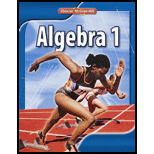
Concept explainers
(a)
To write: An algebraic expression to represent the number of times shadow is shown in
(a)
Answer to Problem 44PPS
Thealgebraic expression is
Explanation of Solution
Given information:
It is given that the most famous groundhog, Punxsutawney Phil in Pennsylvania sees his shadow
Calculation:
The most famous groundhog, Punxsutawney Phil in Pennsylvania, sees his shadow
The algebraic expression representing the number of times he sees his shadow in
Therefore, the algebraic expression is
(b)
To check: The given scenario is true of false for the given conditional statement.
(b)
Answer to Problem 44PPS
Thetrue or false is shown in table (1).
Explanation of Solution
Given information:
The statement are“if Groundhog sees its shadow, then there will be 6 more weeks of winter” and “if it does not see its shadow, then there will be an early spring.”
Calculation:
On Groundhog day, if Groundhog sees his shadow, then there will be 6 more weeks of winter. If it does not see his shadow, then there will be an early spring.
According to the given statement the following table is completed.
| Sees his shadow or not | 6 more weeks of winter or an early spring | True or false |
| Shadow | Winter | True |
| Shadow | Spring | False |
| No Shadow | Winter | False |
| No Shadow | Spring | True |
Table (1)
Hence, the true or false is shown in table (1).
(c)
The situations listed in the table could be considered as a counterexample to the original statement.
(c)
Answer to Problem 44PPS
Thesecond and third situations explain the counterexample for the given statements.
Explanation of Solution
Given information:
The statement are “if Groundhog sees its shadow, then there will be 6 more weeks of winter” and “if it does not see its shadow, then there will be an early spring.”
Calculation:
Consider the first statement.
“If Groundhog sees its shadow, then there will be 6 more weeks of winter.”
One counter example to this statement from the table is as follows.
“If Groundhog sees his shadow, then there will be an early spring” according to second row of table (1).
Consider the second statement.
“If it does not see its shadow, then there will be an early spring.”
One counter example to this statement from the table is as follows.
“If Groundhog sees its shadow, then there will be 6 more weeks of winter” according to third row of table (1).
Chapter 1 Solutions
Algebra 1
Additional Math Textbook Solutions
Introductory Statistics
A First Course in Probability (10th Edition)
Intro Stats, Books a la Carte Edition (5th Edition)
Pre-Algebra Student Edition
Calculus: Early Transcendentals (2nd Edition)
A Problem Solving Approach To Mathematics For Elementary School Teachers (13th Edition)
- Safari File Edit View History Bookmarks Window Help Ο Ω OV O mA 0 mW ర Fri Apr 4 1 222 tv A F9 F10 DII 4 F6 F7 F8 7 29 8 00 W E R T Y U S D பட 9 O G H J K E F11 + 11 F12 O P } [arrow_forwardSo confused. Step by step instructions pleasearrow_forwardIn simplest terms, Sketch the graph of the parabola. Then, determine its equation. opens downward, vertex is (- 4, 7), passes through point (0, - 39)arrow_forward
- In simplest way, For each quadratic relation, find the zeros and the maximum or minimum. a) y = x 2 + 16 x + 39 b) y = 5 x2 - 50 x - 120arrow_forwardIn simplest terms and step by step Write each quadratic relation in standard form, then fi nd the zeros. y = - 4( x + 6)2 + 36arrow_forwardIn simplest terms and step by step For each quadratic relation, find the zeros and the maximum or minimum. 1) y = - 2 x2 - 28 x + 64 2) y = 6 x2 + 36 x - 42arrow_forward
- Write each relation in standard form a)y = 5(x + 10)2 + 7 b)y = 9(x - 8)2 - 4arrow_forwardIn simplest form and step by step Write the quadratic relation in standard form, then fi nd the zeros. y = 3(x - 1)2 - 147arrow_forwardStep by step instructions The path of a soccer ball can be modelled by the relation h = - 0.1 d 2 + 0.5 d + 0.6, where h is the ball’s height and d is the horizontal distance from the kicker. a) Find the zeros of the relation.arrow_forward
 Algebra and Trigonometry (6th Edition)AlgebraISBN:9780134463216Author:Robert F. BlitzerPublisher:PEARSON
Algebra and Trigonometry (6th Edition)AlgebraISBN:9780134463216Author:Robert F. BlitzerPublisher:PEARSON Contemporary Abstract AlgebraAlgebraISBN:9781305657960Author:Joseph GallianPublisher:Cengage Learning
Contemporary Abstract AlgebraAlgebraISBN:9781305657960Author:Joseph GallianPublisher:Cengage Learning Linear Algebra: A Modern IntroductionAlgebraISBN:9781285463247Author:David PoolePublisher:Cengage Learning
Linear Algebra: A Modern IntroductionAlgebraISBN:9781285463247Author:David PoolePublisher:Cengage Learning Algebra And Trigonometry (11th Edition)AlgebraISBN:9780135163078Author:Michael SullivanPublisher:PEARSON
Algebra And Trigonometry (11th Edition)AlgebraISBN:9780135163078Author:Michael SullivanPublisher:PEARSON Introduction to Linear Algebra, Fifth EditionAlgebraISBN:9780980232776Author:Gilbert StrangPublisher:Wellesley-Cambridge Press
Introduction to Linear Algebra, Fifth EditionAlgebraISBN:9780980232776Author:Gilbert StrangPublisher:Wellesley-Cambridge Press College Algebra (Collegiate Math)AlgebraISBN:9780077836344Author:Julie Miller, Donna GerkenPublisher:McGraw-Hill Education
College Algebra (Collegiate Math)AlgebraISBN:9780077836344Author:Julie Miller, Donna GerkenPublisher:McGraw-Hill Education





